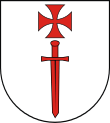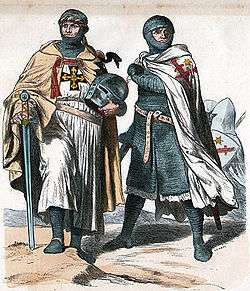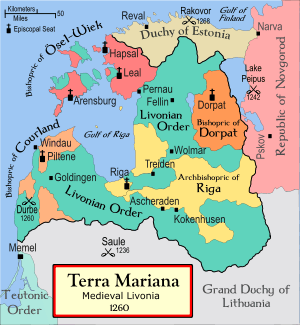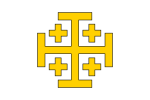Livonian Brothers of the Sword
The Livonian Brothers of the Sword (Latin: Fratres militiæ Christi Livoniae, German: Schwertbrüderorden, French: Ordre des Chevaliers Porte-Glaive) was a Catholic military order established by Albert, the third bishop of Riga (or possibly by Theoderich von Treyden), in 1202. Pope Innocent III sanctioned the establishment in 1204 for the second time. The membership of the order comprised German "warrior monks" who fought Baltic and Finnic pagans in the area of modern-day Estonia, Latvia and Lithuania. Alternative names of the Order include Christ Knights, Swordbrothers, Sword Brethren, and The Militia of Christ of Livonia. The seal reads: +MAGISTRI ETFRM (et fratrum) MILICIE CRI (Christi) DE LIVONIA.
| Livonian Brothers of the Sword (Fratres militiæ Christi Livoniae) | |
|---|---|
 
| |
| Active | 1204–1237 |
| Country | Terra Mariana |
| Allegiance | Catholic Church |
| Garrison/HQ | Wenden (Cēsis), Fellin (Viljandi), Segewold (Sigulda). Ascheraden (Aizkraukle), Goldingen (Kuldīga), Marienburg (Alūksne), Reval (Tallinn), Weißenstein (Paide) |
| Battle honours | Livonian Crusade |
Following their defeat by the Samogitians and Semigallians in the Battle of Schaulen (Saule) in 1236, the surviving Brothers merged into the Teutonic Order as an autonomous branch and became known as the Livonian Order.
History

Albert, Bishop of Riga (also called Prince-Bishop of Livonia) (or possibly Theoderich von Treyden),[1] founded the Brotherhood in 1202 to aid the Bishopric of Livonia in the conversion of the pagan Livonians, Latgalians and Selonians living across the ancient trade routes from the Gulf of Riga eastwards. From its foundation, the undisciplined Order tended to ignore its supposed vassalage to the bishops. In 1218, Albert asked King Valdemar II of Denmark for assistance, but Valdemar instead arranged a deal with the Brotherhood and conquered northern Estonia (now known as Danish Estonia) for Denmark.
The Brotherhood had its headquarters at Fellin (Viljandi) in present-day Estonia, where the walls of the Master's castle still stand. Other strongholds included Wenden (Cēsis), Segewold (Sigulda) and Ascheraden (Aizkraukle). The commanders of Fellin, Goldingen (Kuldīga), Marienburg (Alūksne), Reval (Tallinn), and the bailiff of Weißenstein (Paide) belonged to the five-member entourage of the Order's Master.
Pope Gregory IX asked the Brothers to defend Finland from the Novgorodian attacks in his letter of November 24, 1232.[2] However, no known information regarding the knights' possible activities in Finland has survived. (Sweden eventually conquered Finland following the Second Swedish Crusade in 1249.)
The Order was decimated in the Battle of Schaulen (Saule) in 1236 against Lithuanians and Semigallians.[3] This disaster led the surviving Brothers to become incorporated into the Order of Teutonic Knights in the following year, and from that point on they became known as the Livonian Order.[3] They continued, however, to function in all respects (rule, clothing and policy) as an autonomous branch of the Teutonic Order, headed by their own Master (himself de jure subject to the Teutonic Order's Grand Master).
See also
- Teutonic Order
- Battle of Saule
- Livonian Crusade
- Northern Crusades
- Order of Dobrin
Gallery
 The Livonian Confederation in 1260.
The Livonian Confederation in 1260.- The Mecklenburgian swordbrother Helmold III. von Plesse.
References
- The Discovery of the Baltic The Reception of a Catholic World-System in the European North (AD 1075-1225) Blomkvist, Nils. 2004 (p.539)
- "Letter by Pope Gregory IX". Archived from the original on 2007-08-14.. (In Latin) Hosted by the National Archive of Finland. See Diplomatarium Fennicum Archived 2007-06-08 at the Wayback Machine
- Andrejs Plakans, A Concise History of the Baltic States, (Cambridge University Press, 2011), 44.
